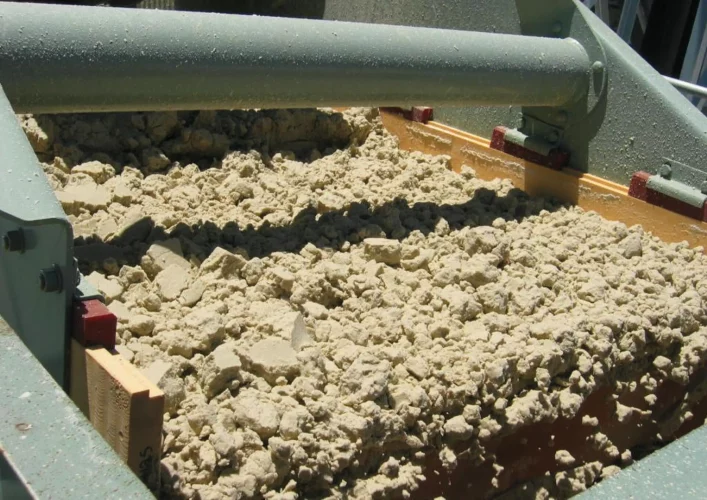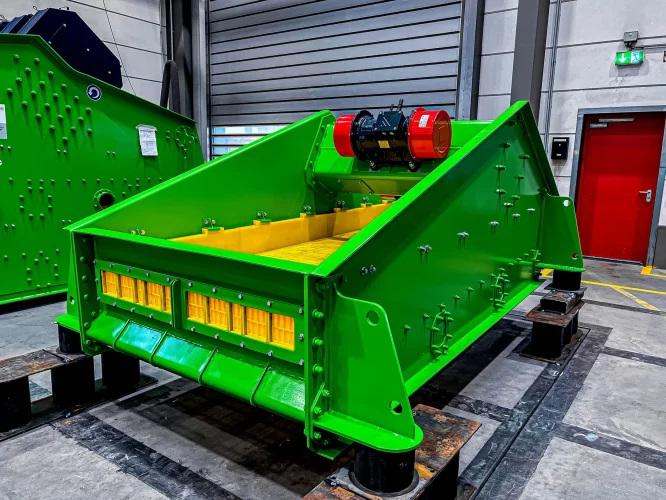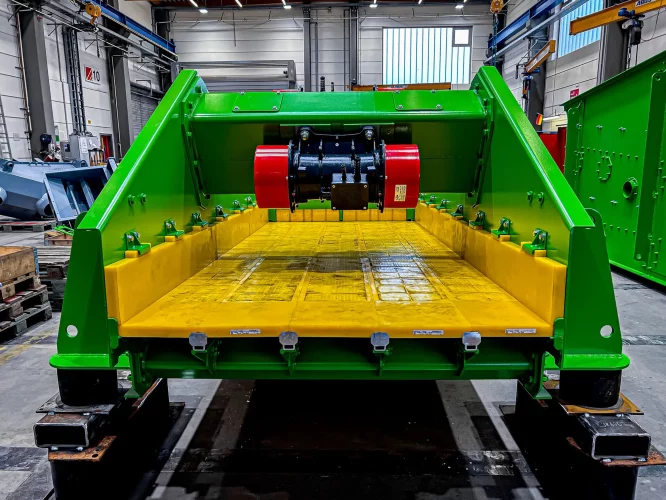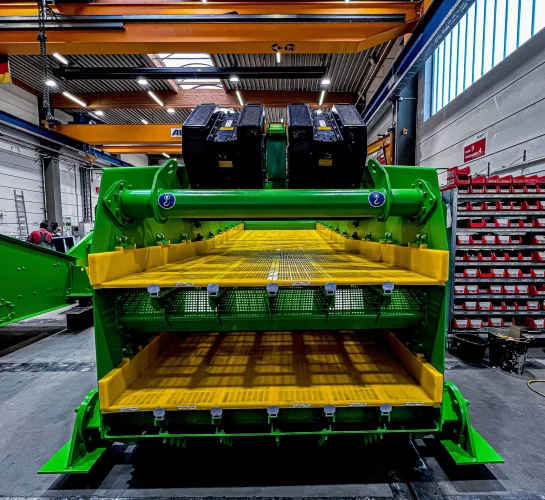Dewatering Screens
JOEST dewatering screens were originally developed for sand dewatering, but are now used in almost all industries where bulk materials need to be specifically dewatered after washing or other wet processes. Whether in ore processing, the minerals industry, plastics or glass recycling – thanks to their robust design and versatile configuration options, these screens have established themselves as high‑performance, compact solutions for achieving very low residual moisture.
The machines operate with linear motion generated by vibratory motors, exciters, or magnetic drives – depending on machine size and application. With an optimized throw angle and high acceleration, JOEST dewatering screens achieve extremely low residual moisture values, even with high throughput rates. Optional features such as fines hoppers, vibration monitoring, or hygienic designs enable precise integration into a wide variety of processes and industries.
FUNCTION
JOEST dewatering screens operate on the principle of directed linear motion, in which the bulk material is conveyed across the screen deck at high acceleration. The vibratory motion is generated by unbalanced motors, exciters, or magnetic drives – depending on machine size, conveying material, and process requirements.
The objective is the efficient separation of liquid and solid phases: while the solids are transported across the screen deck, the water passes downward through the screen media. A key factor for performance is the optimized throw angle – it ensures that the material is not only dewatered but also well stratified, allowing particles to loosen and excess water to drain more easily.
The screen media – e.g., PU mats or wire mesh – are selected according to the particle size and moisture content. The linear material flow combined with high vibration acceleration results in highly effective dewatering with very low residual moisture, even with high throughput rates and wet, sticky materials.
Thanks to their modular design, the dewatering screens can be precisely tailored to the specific application – whether for compact plants, downstream drying stages, or as part of conveying and washing systems.
OPTIONS
- Various drive types: unbalanced motor, exciter, magnetic drive
- Screen media such as PU or wire mesh
- Modular design for customized configuration
- Wear protection and reinforced design for abrasive materials
- Fines hopper and discharge chutes as accessories
- Dust or splash protection covers
- Maintenance openings and inspection flaps
- ATEX‑compliant design available upon request
- Hygienic stainless steel versions for sensitive applications
Fields of Application
JOEST dewatering screens are used wherever wet bulk materials must be reliably separated from excess water – whether directly after washing processes, as preparation before drying stages, or for classification of moist materials. With their robust design and high dewatering performance, they can be used across industries – even with sticky, abrasive, or hard‑to‑dewater products.
Sand, gravel, crushed sand
Ores, rocks, slags, minerals
Glass cullet, plastic regrind, construction and demolition waste
Starch, fibers, residues from wet processes
Equipment Options
For optimal integration into your processes, JOEST dewatering screens can be individually configured with a wide range of options – technically sophisticated, proven in practice, and flexibly combinable.
Flexible Drive Selection
Unbalanced motors, exciters, or magnetic drives – the vibration system is optimally matched to the product, screen size, and desired conveying characteristics.
Individually Selectable Screen Media
PU mats or wire mesh are available – selected according to particle size, moisture content, wear behavior, and cleaning properties.
Modular Design for Easy Customization
The machines are of modular construction, allowing flexible adaptation to individual process requirements, space constraints, or interface specifications.
Wear Protection for Abrasive Materials
For highly demanding media, screen decks and contact surfaces can be equipped with replaceable wear elements or special protective linings.
Fines Hopper and Discharge Chutes as Accessories
Optional fines hoppers or discharge chutes can be integrated – for targeted water removal or precise fines discharge.
Splash Guard Covers
Protective covers with viewing windows or inspection flaps ensure safer, cleaner processes and improved working conditions on site.
ATEX‑Compliant Design
Upon request, all dewatering screens are available in gas‑ or dust‑proof, ATEX‑compliant design with certified components.
Hygienic Stainless Steel Versions Available
For applications with high hygiene requirements or corrosion protection needs, stainless steel designs with smooth surfaces can be implemented.
Advantages
JOEST dewatering screens stand out with reliable technology, robust construction, and outstanding dewatering performance – even with high throughput rates and challenging materials. The combination of linear motion, precise screening technology, and modular design allows them to be optimally tailored to individual requirements.
Efficient Residual Water Separation at High Throughput
The linear motion with an optimized throw angle ensures effective stratification and dewatering – even with large material volumes.
Reliable Operation Under Demanding Conditions
Thanks to a robust design, durable drive technology, and reinforced components, ideally suited for abrasive or sticky materials.
Available in Stainless Steel or ATEX‑Compliant Design
For hygienically or safety‑critical areas, suitable versions are available with certified materials and components.
Very Low Residual Moisture
The special motion of the screen deck creates a loose material layer – water drains faster and residual moisture is minimized.
Versatile Drive Concepts Available
Unbalanced motors, exciters, or magnetic drives – individually selectable depending on machine size, space requirements, and desired dynamic performance.
Optimal Adaptation to Material and Process
Drive, screen media, and machine design are precisely matched to material properties, residual moisture targets, and plant layout.
Modular Design for Easy Integration
The machines can be flexibly integrated into new or existing plants – with customizable length, width, configuration, and dewatering section.
Your Material. Our Test Center.
Before a solution reaches you, it is thoroughly tested in our in‑house technical center. Here, we test your materials under real‑world conditions and develop optimal, practical concepts.












